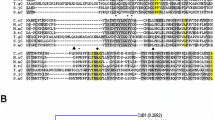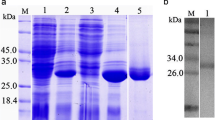Abstract
Aminopeptidases serve vital roles in metabolism of hormones, neurotransmission, turnover of proteins and immunological regulations. Leucine aminopeptidases catalyze the hydrolysis of amino-acid residues from the N-terminus of proteins and peptides. In the present study, leucine aminopeptidase 2 (LAP2) gene of Clonorchis sinensis (C. sinensis) was isolated and identified from an adult cDNA library of C. sinensis. Recombinant CsLAP2 was expressed and purified in Escherichia coli BL21. The open reading frame of LAP2 contains 1,560 bp equivalent to 519 amino acids, a similarity analysis showed a relatively low homology with Homo sapiens (19.0 %), Trypanosoma cruzi (18.0 %), Mus musculus (19.3 %), and relatively high homology with Schistosoma mansoni (65.6 %). The optimum condition of rCsLAP2 enzyme activity was investigated using a fluorescent substrate of Leu-MCA at 37 °C and pH 7.5. The K m and V max values of rCsLAP2 were 18.2 μM and 10.7 μM/min, respectively. CsLAP2 gene expression can be detected at the stages of the adult worm, metacercaria, excysted metacercaria and egg of C. sinensis using real-time PCR, no difference was observed at the stages of the adult worm, metacercaria and egg. However, CsLAP2 showed a higher expression level at the stage of excysted metacercaria than the adult worm (3.90-fold), metacercaria (4.60-fold) and egg (4.59-fold). Histochemistry analysis showed that CsLAP2 was located at the tegument and excretory vesicle of metacercaria, and the tegument and intestine of adult worm. The immune response specific to rCsLAP2 was characterized by a mixed response patterns of Th1 and Th2, indicating a compounded humoral and cellular immune response. The combined results from the present study indicate that CsLAP2 was an important antigen exposed to host immune system, and probably implicated as potential role in interaction with host cells in clonorchiasis.








Similar content being viewed by others
References
Lun ZR, Gasser RB, Lai DH, Li AX, Zhu XQ et al (2005) Clonorchiasis: a key foodborne zoonosis in China. Lancet Infect Dis 5:31–41
Choi BI, Han JK, Hong ST, Lee KH (2004) Clonorchiasis and cholangiocarcinoma: etiologic relationship and imaging diagnosis. Clin Microbiol Rev 17:540–552
Mayer DA, Fried B (2007) The role of helminth infections in carcinogenesis. Adv Parasitol 65:239–296
Rim HJ (2005) Clonorchiasis: an update. J Helminthol 79:269–281
Wang CR, Qiu JH, Zhao JP, Xu LM, Yu WC et al (2006) Prevalence of helminthes in adult dogs in Heilongjiang Province, the People’s Republic of China. Parasitol Res 99:627–630
Zhou Z, Xia H, Hu X, Huang Y, Li Y et al (2008) Oral administration of a Bacillus subtilis spore-based vaccine expressing Clonorchis sinensis tegumental protein 22.3 kDa confers protection against Clonorchis sinensis. Vaccine 26:1817–1825
Li Y, Hu X, Liu X, Xu J, Hu F et al (2009) Molecular cloning and analysis of stage and tissue-specific expression of Cathepsin L-like protease from Clonorchis sinensis. Parasitol Res 105:447–452
Tian F, Lin D, Wu J, Gao Y, Zhang D et al (2010) Immune events associated with high level protection against Schistosoma japonicum infection in pigs immunized with UV-attenuated cercariae. PLoS One 5:e13408
Teixeira de Melo T, Michel de Araujo J, Do Valle Duraes F, Caliari MV, Oliveira SC et al (2010) Immunization with newly transformed Schistosoma mansoni schistosomula tegument elicits tegument damage, reduction in egg and parasite burden. Parasite Immunol 32:749–759
Chemale G, Perally S, LaCourse EJ, Prescott MC, Jones LM et al (2010) Comparative proteomic analysis of triclabendazole response in the liver fluke Fasciola hepatica. J Proteome Res 9:4940–4951
Kofta W, Mieszczanek J, Plucienniczak G, Wedrychowicz H (2000) Successful DNA immunisation of rats against fasciolosis. Vaccine 18:2985–2990
Lee JS, Kim IS, Sohn WM, Lee J, Yong TS (2006) A DNA vaccine encoding a fatty acid-binding protein of Clonorchis sinensis induces protective immune response in Sprague-Dawley rats. Scand J Immunol 63:169–176
Piacenza L, Acosta D, Basmadjian I, Dalton JP, Carmona C (1999) Vaccination with cathepsin L proteinases and with leucine aminopeptidase induces high levels of protection against fascioliasis in sheep. Infect Immun 67:1954–1961
Curley GP, O’Donovan SM, McNally J, Mullally M, O’Hara H et al (1994) Aminopeptidases from Plasmodium falciparum, Plasmodium chabaudi chabaudi and Plasmodium berghei. J Eukaryot Microbiol 41:119–123
Marcilla A, De la Rubia JE, Sotillo J, Bernal D, Carmona C et al (2008) Leucine aminopeptidase is an immunodominant antigen of Fasciola hepatica excretory and secretory products in human infections. Clin Vaccine Immunol 15:95–100
Jia H, Nishikawa Y, Luo Y, Yamagishi J, Sugimoto C et al (2010) Characterization of a leucine aminopeptidase from Toxoplasma gondii. Mol Biochem Parasitol 170:1–6
Rinaldi G, Morales ME, Alrefaei YN, Cancela M, Castillo E et al (2009) RNA interference targeting leucine aminopeptidase blocks hatching of Schistosoma mansoni eggs. Mol Biochem Parasitol 167:118–126
Zhou LG, Liu BX, Sun LC, Hara K, Su WJ et al (2010) Identification of an aminopeptidase from the skeletal muscle of grass carp (Ctenopharyngodon idellus). Fish Physiol Biochem 36:953–962
Acosta D, Cancela M, Piacenza L, Roche L, Carmona C et al (2008) Fasciola hepatica leucine aminopeptidase, a promising candidate for vaccination against ruminant fasciolosis. Mol Biochem Parasitol 158:52–64
Song L, Chen S, Yu X, Wu Z, Xu J et al (2004) Molecular cloning and characterization of cDNA encoding a ubiquitin-conjugating enzyme from Clonorchis sinensis. Parasitol Res 94:227–232
Zheng N, Xu J, Wu Z, Chen J, Hu X et al (2005) Clonorchis sinensis: molecular cloning and functional expression of novel cytosolic malate dehydrogenase. Exp Parasitol 109:220–227
Umetsu H, Arai M, Ota T, Kudo R, Sugiura H et al (2003) Purification and properties of an aminopeptidase from the mid-gut gland of scallop (Patinopecten yessoensis). Comp Biochem Physiol B: Biochem Mol Biol 136:935–942
Vickers I, Reeves EP, Kavanagh KA, Doyle S (2007) Isolation, activity and immunological characterisation of a secreted aspartic protease, CtsD, from Aspergillus fumigatus. Protein Expr Purif 53:216–224
Guillou F, Roger E, Mone Y, Rognon A, Grunau C et al (2007) Excretory-secretory proteome of larval Schistosoma mansoni and Echinostoma caproni, two parasites of Biomphalaria glabrata. Mol Biochem Parasitol 155:45–56
Kang JM, Sohn WM, Ju JW, Kim TS, Na BK (2010) Identification and characterization of a serine protease inhibitor of Clonorchis sinensis. Acta Trop 116:134–140
Na BK, Kang JM, Sohn WM (2008) CsCF-6, a novel cathepsin F-like cysteine protease for nutrient uptake of Clonorchis sinensis. Int J Parasitol 38:493–502
Yoo WG, Kim TI, Li S, Kwon OS, Cho PY et al (2009) Reference genes for quantitative analysis on Clonorchis sinensis gene expression by real-time PCR. Parasitol Res 104:321–328
Bai RK, Wong LJ (2004) Detection and quantification of heteroplasmic mutant mitochondrial DNA by real-time amplification refractory mutation system quantitative PCR analysis: a single-step approach. Clin Chem 50:996–1001
Hernandez-Gonzalez A, Valero ML, del Pino MS, Oleaga A, Siles-Lucas M (2010) Proteomic analysis of in vitro newly excysted juveniles from Fasciola hepatica. Mol Biochem Parasitol 172:121–128
Liu F, Cui SJ, Hu W, Feng Z, Wang ZQ et al (2009) Excretory/secretory proteome of the adult developmental stage of human blood fluke, Schistosoma japonicum. Mol Cell Proteomics 8:1236–1251
Zimic MJ, Infantes J, Lopez C, Velasquez J, Farfan M et al (2007) Comparison of the peptidase activity in the oncosphere excretory/secretory products of Taenia solium and Taenia saginata. J Parasitol 93:727–734
Acosta D, Goni F, Carmona C (1998) Characterization and partial purification of a leucine aminopeptidase from Fasciola hepatica. J Parasitol 84:1–7
Pokharel DR, Rathaur S (2008) Purification and characterization of a leucine aminopeptidase from the bovine filarial parasite Setaria cervi. Acta Trop 106:1–8
McCarthy E, Stack C, Donnelly SM, Doyle S, Mann VH et al (2004) Leucine aminopeptidase of the human blood flukes, Schistosoma mansoni and Schistosoma japonicum. Int J Parasitol 34:703–714
Mulvenna J, Moertel L, Jones MK, Nawaratna S, Lovas EM et al (2010) Exposed proteins of the Schistosoma japonicum tegument. Int J Parasitol 40:543–554
Jones MK, Gobert GN, Zhang L, Sunderland P, McManus DP (2004) The cytoskeleton and motor proteins of human schistosomes and their roles in surface maintenance and host-parasite interactions. BioEssays 26:752–765
Van Hellemond JJ, Retra K, Brouwers JF, van Balkom BW, Yazdanbakhsh M et al (2006) Functions of the tegument of schistosomes: clues from the proteome and lipidome. Int J Parasitol 36:691–699
Mulvenna J, Sripa B, Brindley PJ, Gorman J, Jones MK et al (2010) The secreted and surface proteomes of the adult stage of the carcinogenic human liver fluke Opisthorchis viverrini. Proteomics 10:1063–1078
Knox DP, Smith WD (2001) Vaccination against gastrointestinal nematode parasites of ruminants using gut-expressed antigens. Vet Parasitol 100:21–32
Park TJ, Kang JM, Na BK, Sohn WM (2009) Molecular cloning and characterization of a paramyosin from Clonorchis sinensis. Korean J Parasitol 47:359–367
Mosmann TR, Coffman RL (1989) Heterogeneity of cytokine secretion patterns and functions of helper T cells. Adv Immunol 46:111–147
Snapper CM, Paul WE (1987) Interferon-gamma and B cell stimulatory factor-1 reciprocally regulate Ig isotype production. Science 236:944–947
Hoffmann KF, James SL, Cheever AW, Wynn TA (1999) Studies with double cytokine-deficient mice reveal that highly polarized Th1- and Th2-type cytokine and antibody responses contribute equally to vaccine-induced immunity to Schistosoma mansoni. J Immunol 163:927–938
Acknowledgments
This work is supported by grants from the National Basic Research Program of China (973 program, No. 2010CB530000), and science and technology projects of Guangzhou (10A31021473).
Author information
Authors and Affiliations
Corresponding author
Rights and permissions
About this article
Cite this article
Deng, C., Sun, J., Li, X. et al. Molecular identification and characterization of leucine aminopeptidase 2, an excretory-secretory product of Clonorchis sinensis . Mol Biol Rep 39, 9817–9826 (2012). https://doi.org/10.1007/s11033-012-1848-9
Received:
Accepted:
Published:
Issue Date:
DOI: https://doi.org/10.1007/s11033-012-1848-9




